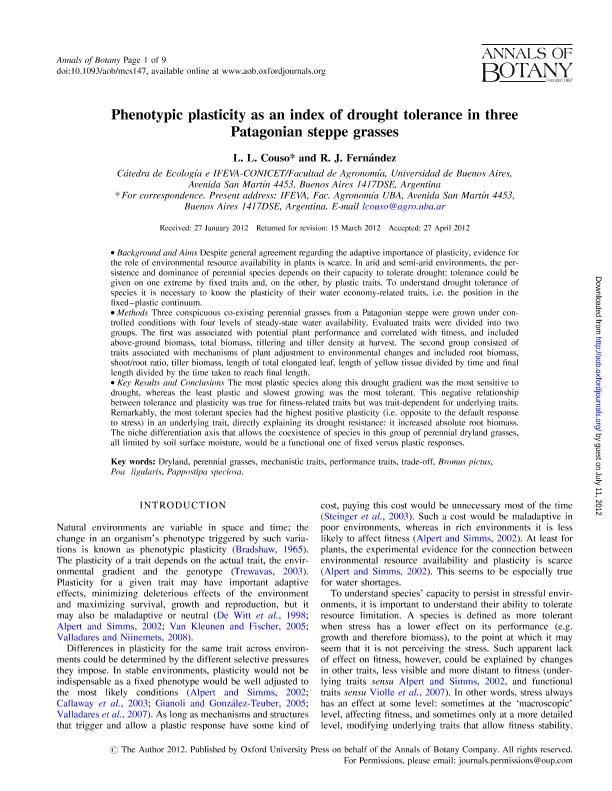Mostrar el registro sencillo del ítem
dc.contributor.author
Couso, Luciana Laura

dc.contributor.author
Fernandez Alduncin, Roberto Javier

dc.date.available
2018-09-19T19:33:41Z
dc.date.issued
2012-09
dc.identifier.citation
Couso, Luciana Laura; Fernandez Alduncin, Roberto Javier; Phenotypic plasticity as an index of drought tolerance in three Patagonian steppe grasses; Oxford University Press; Annals of Botany; 110; 4; 9-2012; 849-857
dc.identifier.issn
0305-7364
dc.identifier.uri
http://hdl.handle.net/11336/60301
dc.description.abstract
Background and AimsDespite general agreement regarding the adaptive importance of plasticity, evidence for the role of environmental resource availability in plants is scarce. In arid and semi-arid environments, the persistence and dominance of perennial species depends on their capacity to tolerate drought: tolerance could be given on one extreme by fixed traits and, on the other, by plastic traits. To understand drought tolerance of species it is necessary to know the plasticity of their water economy-related traits, i.e. the position in the fixedplastic continuum.MethodsThree conspicuous co-existing perennial grasses from a Patagonian steppe were grown under controlled conditions with four levels of steady-state water availability. Evaluated traits were divided into two groups. The first was associated with potential plant performance and correlated with fitness, and included above-ground biomass, total biomass, tillering and tiller density at harvest. The second group consisted of traits associated with mechanisms of plant adjustment to environmental changes and included root biomass, shoot/root ratio, tiller biomass, length of total elongated leaf, length of yellow tissue divided by time and nal length divided by the time taken to reach nal length.Key Results and ConclusionsThe most plastic species along this drought gradient was the most sensitive to drought, whereas the least plastic and slowest growing was the most tolerant. This negative relationship between tolerance and plasticity was true for fitness-related traits but was trait-dependent for underlying traits. Remarkably, the most tolerant species had the highest positive plasticity (i.e. opposite to the default response to stress) in an underlying trait, directly explaining its drought resistance: it increased absolute root biomass. The niche differentiation axis that allows the coexistence of species in this group of perennial dryland grasses, all limited by soil surface moisture, would be a functional one of fixed versus plastic responses. © 2012 The Author.
dc.format
application/pdf
dc.language.iso
eng
dc.publisher
Oxford University Press

dc.rights
info:eu-repo/semantics/openAccess
dc.rights.uri
https://creativecommons.org/licenses/by-nc-sa/2.5/ar/
dc.subject
Bromus Pictus
dc.subject
Dryland
dc.subject
Mechanistic Traits
dc.subject
Pappostipa Speciosa
dc.subject
Perennial Grasses
dc.subject
Performance Traits
dc.subject
Poa Ligularis
dc.subject
Trade-Off
dc.subject.classification
Otras Ciencias Biológicas

dc.subject.classification
Ciencias Biológicas

dc.subject.classification
CIENCIAS NATURALES Y EXACTAS

dc.title
Phenotypic plasticity as an index of drought tolerance in three Patagonian steppe grasses
dc.type
info:eu-repo/semantics/article
dc.type
info:ar-repo/semantics/artículo
dc.type
info:eu-repo/semantics/publishedVersion
dc.date.updated
2018-09-10T16:30:08Z
dc.journal.volume
110
dc.journal.number
4
dc.journal.pagination
849-857
dc.journal.pais
Reino Unido

dc.journal.ciudad
Oxford
dc.description.fil
Fil: Couso, Luciana Laura. Consejo Nacional de Investigaciones Científicas y Técnicas. Oficina de Coordinación Administrativa Parque Centenario. Instituto de Investigaciones Fisiológicas y Ecológicas Vinculadas a la Agricultura. Universidad de Buenos Aires. Facultad de Agronomía; Argentina
dc.description.fil
Fil: Fernandez Alduncin, Roberto Javier. Consejo Nacional de Investigaciones Científicas y Técnicas. Oficina de Coordinación Administrativa Parque Centenario. Instituto de Investigaciones Fisiológicas y Ecológicas Vinculadas a la Agricultura. Universidad de Buenos Aires. Facultad de Agronomía; Argentina
dc.journal.title
Annals of Botany

dc.relation.alternativeid
info:eu-repo/semantics/altIdentifier/doi/https://dx.doi.org/10.1093/aob/mcs147
dc.relation.alternativeid
info:eu-repo/semantics/altIdentifier/url/https://academic.oup.com/aob/article/110/4/849/149468
Archivos asociados
